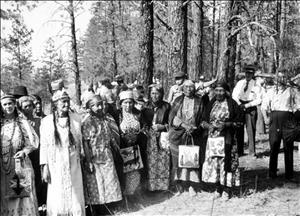On June 14, 1940, Native Americans from throughout the Northwest gather at Kettle Falls for a three-day “Ceremony of Tears” to mourn the loss of their ancestral fishing grounds, soon to be flooded by Grand Coulee Dam on the Columbia River in Central Washington.
Kettle Falls was second only to Celilo Falls (which was inundated by The Dalles Dam in 1957) as a fishing and gathering place for Native Americans along the Columbia. Salish speakers called it Shonitkwu, meaning roaring or noisy waters. European settlers in the late nineteenth century named it Kettle Falls, after the great depressions -- or kettles -- carved by the pounding of water on the huge rocks on the edges of the river. For centuries, Indians had come together at the falls to fish, trade, and socialize. "This is where people met, got married, had babies, settled disputes," said Patti Stone, a member of the Colville Confederated Tribes (Los Angeles Times, 2002).
It was said that salmon were once so plentiful at Kettle Falls that a man could walk across the river on their backs. Huge numbers of fish began arriving in late June, continuing through October, en route to their spawning grounds upriver. Fishing here was dangerous, because of the rushing water and slippery rocks, and required a high degree of organization. A salmon chief, or “Chief of the Waters,” opened the season by spearing the first fish. He also supervised the building of scaffolds that were cantilevered over the water, and the placement of large J-shaped basket traps alongside the rocks. At the end of the day, he divided the catch among the families.
Fishermen speared and netted up to 3,000 fish in a single day. “When fish were running, Kettle Falls was a place of excitement and festivity, drawing more than a thousand people annually,” wrote historian William Layman. “The camps bustled with activity -- a rich assortment of families sharing the work of fishing by day and the pleasure of singing, dancing, and gambling at night” (Layman, 23).
With Grand Coulee Dam nearing completion in June 1940, the U.S. Department of Interior ordered the closure of the Kettle Falls fishery. On June 14, members of tribes from the Colville Reservation in Eastern Washington, Tulalips from Western Washington, Blackfoot from Montana, and Nez Perce, Yakimas, Flatheads, Coeur d’Alenes gathered at the site to mark the end of a way of life that had developed over thousands of years. The Spokane Spokesman Review counted 1,000 people, but writer William D. Layman put the figure at 8,000 to 10,000.
"On horseback and in automobiles, by motor truck and buggy, Indians of the Northwest gathered today," the Spokesman Review reported. "Braves in feathers and beaded buckskin talked in the midway with college-taught Indians in slacks and sports coats in the best Hollywood fashion."
Six chiefs from the Colville Reservation addressed the crowd in their native language with the assistance of a loud speaker system. They mourned not only the loss of the fishery but the destruction of thousands of acres of food-producing bottomlands, source of the roots and berries that were an important part of their traditional diet.
U.S. Senator Homer Bone (1883-1970), a main proponent of the Grand Coulee project, was an honored speaker. That week, the German Army had marched into Paris, and France was capitulating to Hitler. Instead of dwelling on the loss of Kettle Falls, the senator focused on the reality of world events:
"We can build more airplanes and tanks and can train more pilots for national defense than any other nation or combination of nations and the quicker we do it the better. We know now that the only thing in this world that Hitler will respect is more force than he controls."The Indians have fished here for thousands of years. They love this spot above all others on their reservation because it is a source both of food and beauty. We should see to it that the electricity which the great dam at Grand Coulee produces shall be delivered to all the people without profit, so that the Indians of future generations, as well as the white men, will find the change made here a great benefit to the people" (Spokesman Review, June 17, 1940).
Congress did not formally authorize the acquisition and clearing of Indian lands along the river until June 29, 1940. About 2,000 members of the Colville Confederated Tribes and about 250 members of the Spokane Tribe had been forced to leave their homes weeks earlier. Within a year, Kettle Falls would be 90 feet below the surface of what is today called Lake Roosevelt.
The Colvilles eventually got electric power, but not as cheaply as other areas.

